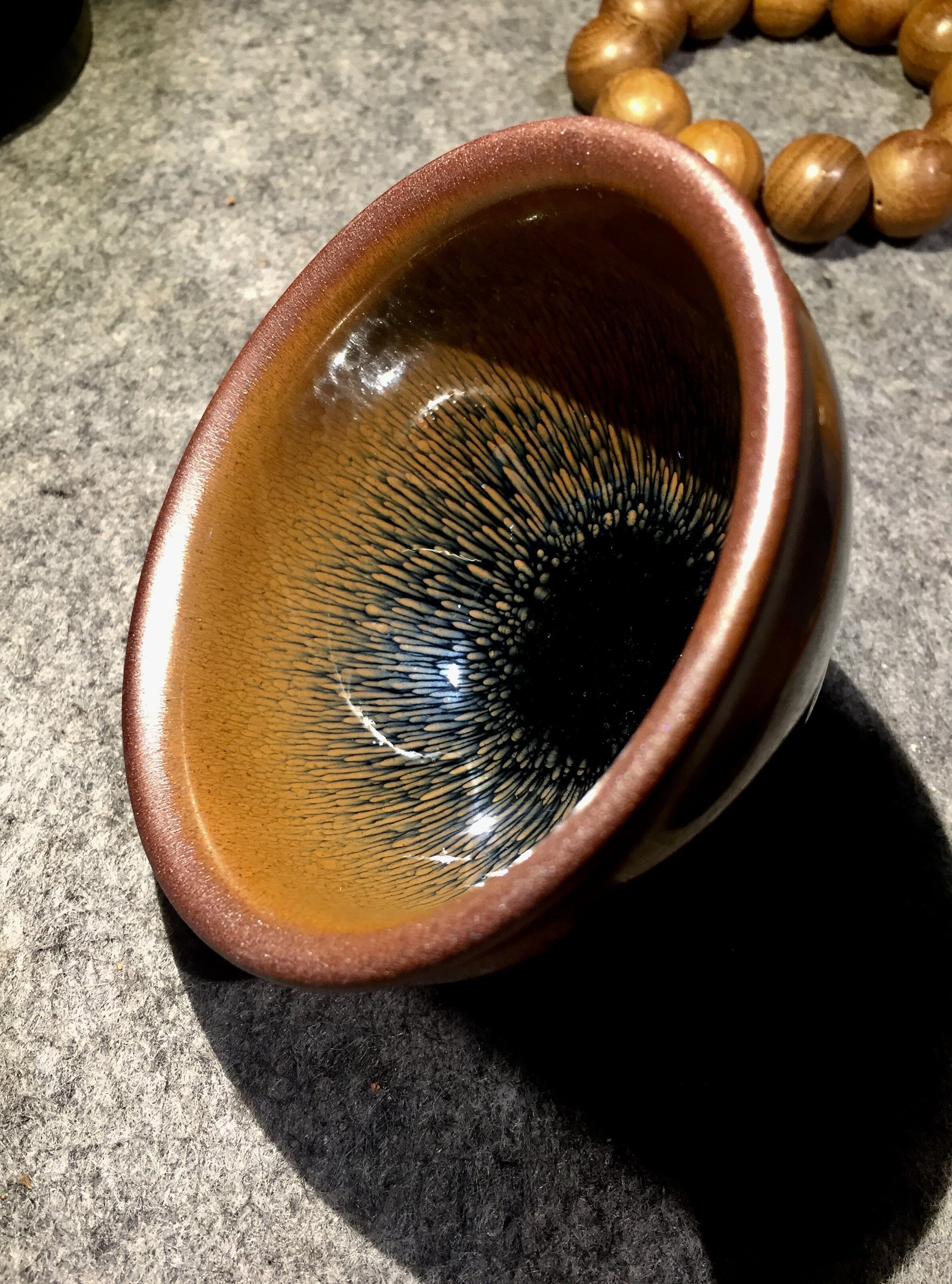The reason why Jian kiln is so fascinating is mainly due to the crystallized glaze kiln transformation patterns. In this article, let Wuyi Tenmoku bring the five glaze color illustrations of Tenmoku for collectors.
Tenmoku's glaze belongs to the category of ancient crystalline glaze, and has a high iron content.
During the high-temperature firing process of over 1300 degrees, due to the fluctuations in temperature and atmosphere inside the kiln, the glaze will produce various unique and natural patterns.
These patterns that are generated by the changes in the glaze itself rather than by artificially controlling the color glaze are called "kiln transformation." The ancients also regarded them as gifts bestowed by the kiln gods.
The charm of Jian kiln lies mainly in the kiln transformation patterns of crystalline glaze.
Currently, there is no recognized authoritative viewpoint on the classification of Tenmoku's glaze colors. This article respects the historical literature records while also using some commonly agreed-upon terms.
Tenmoku's glaze colors can be roughly divided into five categories:
They are black glaze, hare's fur glaze, oil drop glaze, temmoku glaze, and miscellaneous color glaze.
One Hem of Purple Clouds Descending from the Sky: Black Glaze.
Black glaze, also known as pure black glaze, has no patterns on its surface and is one of the classic glaze colors of Jian kiln. Some surfaces are as black as lacquer, while others have a hint of blue in the black, also known as "gàn black glaze" or "wu jin glaze".
The term "gàn black" was recorded in the book "Tea Record" written by Cai Xiang: "Made in Jian'an, it is gàn black, with patterns like hare's fur."
Some black-glazed Tenmoku fired in the early stage of Jian kiln are also called soy black glaze Tenmoku. The glaze recipe is different from that of the mature period, and the glaze is generally thinner, with a rigid surface that may not be black enough or tends to be dry and astringent.
▲Early Northern Song soy black glaze Tenmoku.
▲Imperial Inscription Wu Jin Glaze Tenmoku for Imperial Use
▲Crackled Old Tenmoku
Golden and Silver Threads Faintly Visible: Hare's Fur Glaze.
Hare's fur glaze is the most typical and largest product of the Jian kiln, so much so that people often use "hare's fur Tenmoku" as a synonym for Tenmoku.

The crystalline patterns of hare's fur Tenmoku consist of evenly and finely distributed black thread-like veins that penetrate through the black glaze layer. They resemble the fur of a rabbit, hence the name "hare's fur."
Poems related to tea-drinking in the Song Dynasty often praised and eulogized hare's fur Tenmoku. Many tea books in the Song Dynasty also regarded Jian kiln's hare's fur Tenmoku as the most prestigious tea cup. "Praise of Tea Ware Illustration" even directly depicted the tea cup as a hare's fur Tenmoku among the twelve types of tea ware, indicating its iconic status.
The hare's fur patterns come in various forms, including long and short, thick and thin, and curved and straight. The color of the patterns can be gold, silver, brown, or other hues, and the distribution can be sparse or dense, with varying coverage ranges.
Hare's fur glaze with different colors have different crystalline structures and main components.
▲Golden Hare's Fur Glaze, Silver Hare's Fur Glaze.
▲Details of Golden and Silver Hare's Fur Glaze Patterns.
▲Samples of Various Hare's Fur Glaze Patterns.
Although the production of hare's fur Tenmoku is higher than that of oil drop and temmoku glaze, the crystalline forms, colors, clarity, and distribution of hare's fur patterns vary greatly. It takes a lot of effort to produce a good hare's fur pattern.

Tenmoku master Ye Lizhong can be regarded as a representative of hare's fur Tenmoku. Master Ye spent more than fifty years researching and developing hare's fur Tenmoku, truly living up to the saying "the superior one has jade-like fine threads."
▲Tenmoku Master Ye Lizhong's Kiln Transformation Hare's Fur Glaze.
Large and Small Drops Falling on a Jade Plate: Oil Drop Glaze.
The use of "oil drop" to describe the patterns on Tenmoku originated in Japan. The earliest recorded usage can be traced back to the "Zenrin Kokka," a book written during the Oei period in Japan (1394-1427).
Other Japanese ancient books such as "Mansai Junchu Gonnikki" and "Inryo-kan Nichiroku" also have records of this.
In Chinese ancient literature, no document has been found to describe Tenmoku with the term "oil drop." Therefore, "oil drop" is an undisputed foreign vocabulary.
Nowadays, "oil drop Tenmoku" has become a commonly used term in the Tenmoku market and academic circles. It has been a conventional and proprietary term for many years.
Using the term "oil drop" to differentiate from "hare's fur" is indeed intuitive and convenient, as the crystalline patterns are distributed like boiling oil drops and resemble scattered dots.
The firing conditions of oil drop Tenmoku are more demanding than those of hare's fur Tenmoku. If the kiln temperature is too low, it is difficult to form dot-like patterns, while if the temperature is too high, the dots may flow into lines.
There are very few surviving and excavated oil drop Tenmoku from the Song Dynasty, and intact ones are even rarer.
▲Song Dynasty Oil Drop Tenmoku - Collection of the Dainichiseika Ceramic Museum in Oita.
▲Song Dynasty Oil Drop Tenmoku - Collection of the Kyushu National Museum in Japan.
▲Samples of Various Oil Drop Glaze Patterns.
As the recognized leader in the Tenmoku industry, Master Li Da's oil drop Tenmoku is worth looking forward to, whether for personal use or collection, as it offers great potential for appreciation.









Share:
Cultivate "Rainbow Light" Tenmoku with these 3 Points
What is the general price of Tenmoku? Let's analyze it in three steps